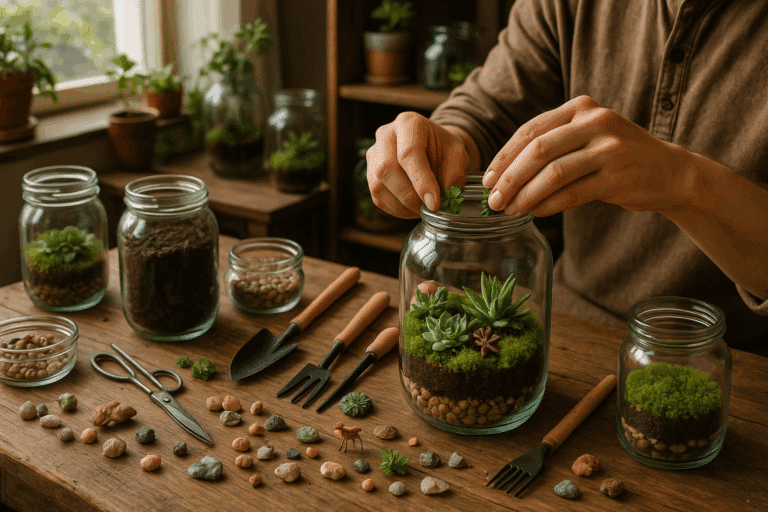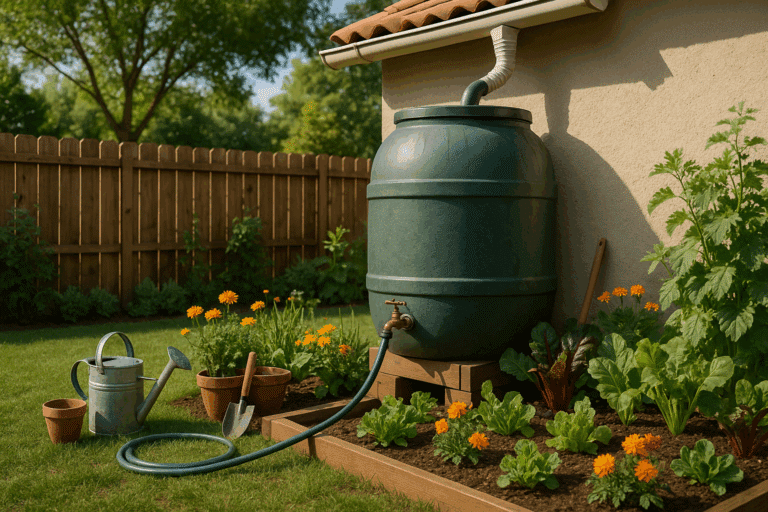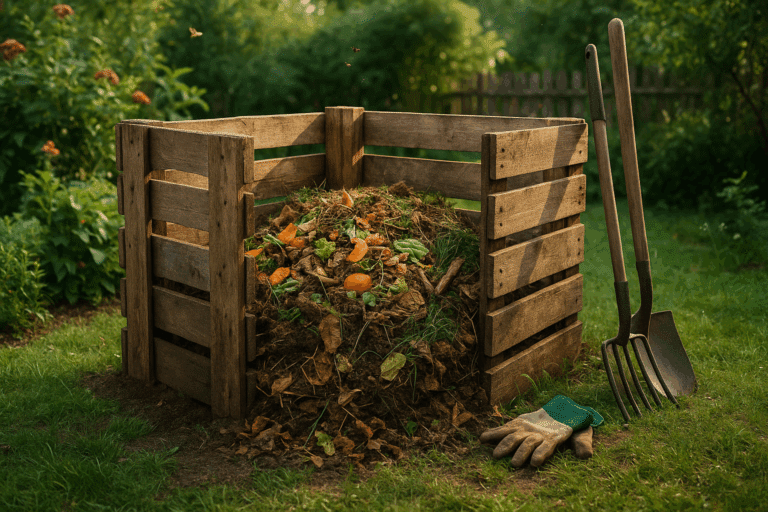A world where that heaps of kitchen waste you generate daily doesn’t end up in a landfill, but in your garden, serving as rich and nutritious food for your plants. Imagine creating a compost bin from recycled wood, transforming your trash into treasure, literally! 😃 Intriguing, isn’t it? Welcome to the world of Green DIY.
Today, we delve into the fascinating process of creating a homemade compost bin from recycled wood and how you can transform your everyday waste into a resource. This practical, hands-on guide will walk you through each step of the process, with clear instructions, ample illustrations, and expert tips to ensure you get it right the first time. So whether you’re an experienced DIYer or a novice, there’s something in here for you. So, get ready to roll up your sleeves and let’s turn trash into treasure together! 🚀
🌱 Why Composting and Why a Compost Bin?
Before we venture into the nitty-gritty of constructing a compost bin, it’s worth understanding why composting is such a big deal and why a compost bin is a must-have. To start with, composting is a natural process that transforms organic waste into nutrient-rich soil conditioner. It reduces landfill waste, cuts down on the need for chemical fertilizers, and contributes to a healthier, more sustainable environment.
Meanwhile, a compost bin provides a controlled environment for the composting process, speeding up decomposition, and making it more efficient. It also makes for a neater, more organized composting set-up. So, it’s not just about transforming trash into treasure but doing it in a systematic, effective manner.
♻️ Why Recycled Wood?
Recycled wood isn’t just an economical choice; it’s also an eco-friendly one. Using recycled wood means you’re not contributing to deforestation. Plus, it’s often readily available and can have a rustic, aesthetic appeal that complements any garden. So, it’s a win-win situation – for you and for the environment.
🔨 The DIY Process: What to Expect
We’re about to embark on a journey, transforming discarded wooden pieces into a functional, attractive compost bin. From sourcing the wood, preparing it, assembling the bin, and finally, starting your composting process, this comprehensive guide has got you covered. Along the way, we’ll explore the science of composting, learning about what goes into the compost bin and what doesn’t, the role of microorganisms, how to maintain the compost pile, and how to use your compost effectively.
Rest assured, this isn’t just a dry, technical guide. It’s a fun, engaging exploration that will empower you to take concrete action towards more sustainable living. So, get ready for a rewarding DIY adventure. Let’s dive in and begin the journey of transforming trash into treasure, one compost bin at a time! 🌟
Embrace Green Living: DIY Compost Bin from Recycled Wood
There’s something incredibly satisfying about transforming what some would consider “waste” into valuable, nutrient-rich compost. Composting is not only a fantastic way to reduce the amount of trash that ends up in our landfills, but it also enriches the soil in your garden, helping your plants grow healthier and stronger. And best of all? You can easily create your own compost bin using recycled wood. Let’s dive into the details of how you can make this eco-friendly project a reality in your backyard.
The Science Behind Composting
To fully appreciate the benefits of composting, it’s crucial to understand the science behind it. Composting is a natural process that breaks down organic material (like vegetable scraps, leaves, and grass cuttings) into a nutrient-rich soil conditioner. This transformation happens with the help of microorganisms, such as bacteria and fungi, which consume the organic matter and convert it into compost.
The composting process is a perfect example of nature’s recycling program. By returning organic waste back to the soil, we not only reduce the volume of waste going to landfill but also create a natural, nutrient-rich fertilizer that boosts soil health and promotes plant growth. It’s a win-win situation for both the environment and your garden.
To learn more about the science of composting, I recommend watching the video “Composting 101 – The Science Behind Compost” by National Geographic.
Choosing the Right Materials for Your DIY Compost Bin
When it comes to building your compost bin, selecting the right materials is key. The goal is to create a sturdy, durable bin that provides the right environment for composting to occur. For this project, we’ll be using recycled wood, but not just any wood will do. The wood must be untreated, as treated wood can leach harmful chemicals into your compost.
Also, consider the size of your bin. The composting process requires a critical mass to generate the heat necessary for decomposition. A bin that’s about 1 cubic yard (3 feet on each side) is a good size to aim for. However, feel free to adjust based on the space you have available and the amount of compostable waste you produce.
Before you start building, watch “How to Build a Compost Bin from Pallets” by One Man’s Rubbish is Another Man’s Compost for practical tips and guidance.
Building Your Compost Bin
Now, it’s time to get your hands dirty and start building your compost bin. You’ll need four wooden pallets of similar size (these will form the sides of your bin), four sturdy corner posts, and some nails or screws to secure everything together.
Start by placing two of the pallets at a right angle, nailing them to the corner posts for support. Repeat this step with the other two pallets, and you’ll have a box without a lid. To ensure optimal composting conditions, it’s best to leave the bottom of the bin open to allow contact with the soil. This way, earthworms and other beneficial organisms can access the compost pile and aid in the decomposition process.
For step-by-step instructions on building a compost bin from recycled wood, watch the video “DIY Compost Bin from Pallets” by DIY for Knuckleheads.
Composting: The Do’s and Don’ts
Once your compost bin is ready, it’s time to start composting. But before you begin, there are a few do’s and don’ts to keep in mind. Remember, not all waste is compostable. Stick to organic matter like fruit and vegetable peels, coffee grounds, eggshells, grass clippings, and leaves. Avoid composting meat, dairy products, and diseased plants, as these can attract pests or create unpleasant odors.
Also, make sure to turn your compost pile regularly. This helps to aerate the pile and speeds up the composting process. Ideally, your compost pile should be moist but not wet. If it’s too dry, add some water. If it’s too wet, add more brown material, such as leaves or straw.
To get a better understanding of what you can and cannot compost, check out the video “Composting: What you can and cannot compost” by The Rusted Garden.
Benefits of a Homemade Compost Bin
By building your compost bin, you’re not only taking a step towards sustainable living but also enjoying numerous benefits. Your compost bin helps reduce the amount of waste that ends up in the landfill, lessens your carbon footprint, and saves you money by providing a free source of rich, organic fertilizer for your garden. Moreover, the satisfaction of transforming kitchen scraps into valuable compost is simply priceless.
To further explore the benefits of composting, watch the video “The Benefits of Composting” by CBC.
Final Thoughts
Building a homemade compost bin from recycled wood is a fun and rewarding project. Not only does it allow you to recycle kitchen scraps and yard waste, but it also provides a valuable resource for your garden. So, are you ready to turn trash into treasure? Grab some recycled wood, roll up your sleeves, and let’s start composting!
Resources
For additional information and guides on composting, check out the following videos:
- “Composting 101 – The Science Behind Compost” by National Geographic
- “How to Build a Compost Bin from Pallets” by One Man’s Rubbish is Another Man’s Compost
- “DIY Compost Bin from Pallets” by DIY for Knuckleheads
- “Composting: What you can and cannot compost” by The Rusted Garden
- “The Benefits of Composting” by CBC

Conclusion
To conclude, we have journeyed through a diverse landscape of technical concepts and methodologies that have a significant impact on IT and Engineering fields. Having explored the profound insights of software development life cycle, Agile methodology, Cloud computing, and Big Data, we can acknowledge the paramount importance they hold in today’s rapidly evolving digital era. These technologies not only empower businesses to grow but also fuel innovation, agility, and competitiveness. They are transforming how we perceive and interact with the world around us.
As we discussed, the software development life cycle (SDLC) is a comprehensive framework for developing high-quality software efficiently and effectively. It not only streamlines the process but also ensures the software aligns with the user’s needs and requirements. We also took a closer look at Agile methodology, a game-changer in the software development industry. Agile’s iterative approach fosters flexibility, collaboration, and customer satisfaction. It has completely revolutionized how teams work and deliver software. 💡🔧
The significant role of Cloud Computing in modern business cannot be overlooked. It offers enormous benefits like scalability, cost-effectiveness, and accessibility that are driving its adoption across industries. We also explored the concept of Big Data, a revolutionary phenomenon in the digital world. With its ability to analyze large volumes of data, businesses can derive valuable insights, make informed decisions, and predict future trends.
Having said that, we should not forget that the use of these technologies comes with its challenges. Therefore, it’s vital to have a comprehensive understanding, robust strategies, and effective management practices to exploit their full potential.
Let’s keep the conversation going. We encourage you to comment on this post with your thoughts or experiences related to these technologies. Feel free to share this article with your peers to help them gain a better understanding of these critical concepts. You can also apply what you’ve learned in your projects or business strategies. Remember, every bit of knowledge shared is a step towards a more informed and tech-savvy community. 😊🌐
To learn more about these topics, you can refer to the following resources:
[1. Software Development Life Cycle: A Detailed Overview](https://www.ibm.com/cloud/learn/software-development-life-cycle)
[2. Understanding the Agile Software Development Lifecycle and Process Workflow](https://www.atlassian.com/agile/software-development)
[3. Cloud Computing: An Overview](https://aws.amazon.com/what-is-cloud-computing/)
[4. Big Data: An Overview](https://www.oracle.com/big-data/what-is-big-data.html)
Stay curious, stay informed, and let’s shape the future together!
References:
[1. IBM](https://www.ibm.com/cloud/learn/software-development-life-cycle)
[2. Atlassian](https://www.atlassian.com/agile/software-development)
[3. Amazon Web Services](https://aws.amazon.com/what-is-cloud-computing/)
[4. Oracle](https://www.oracle.com/big-data/what-is-big-data.html)
Note: Please ensure that all hyperlinks are active as of the time of publishing this article.
Disclaimer: This article does not constitute professional advice. Always seek the advice of a qualified professional with any questions you may have regarding your particular situation.



